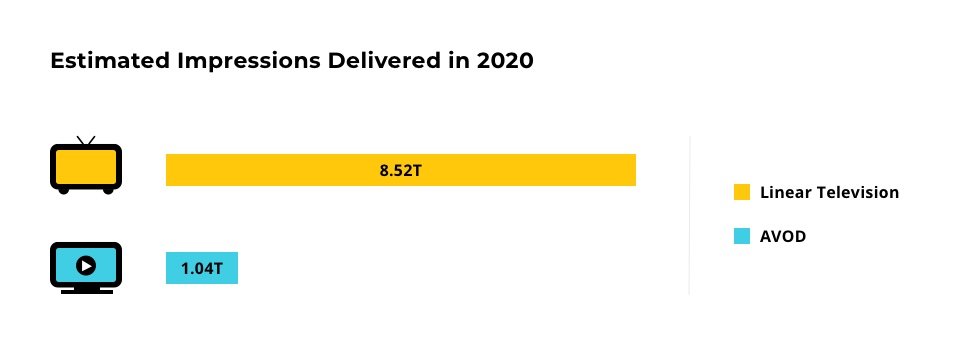We’ve all heard it before: TV is good for branding and delivering mass reach, but it’s expensive, hard to measure and the audience is shrinking. We want to set the record straight on some common misconceptions about TV advertising and how TV can operate with the speed, accountability and precision of digital.
While we’ll start to scratch the surface in this post, be sure to join us for our session on January 20th at 3:15pm ET with Robert Tas, Chief Growth Officer at 1-800-Flowers. He’ll be joined by Simulmedia CEO, Dave Morgan, to discuss how TV can target with precision to reach new audiences and how to spend your TV budget with accountability, transparency and flexibility.
TV delivers massive scale and branding power
Data-driven linear television reaches 112M households with internet access. Based on Simulmedia’s viewership data and reporting from JP Morgan, just three million households subscribe to only ad-supported streaming. While younger viewers (12-17) and their slightly older Millennial counterparts (18-35) have more readily adopted streaming options (CTV/OTT), adults aged 18+ are still watching 3+ hours per day of linear TV on average according to Nielsen.

When considering linear TV’s scale in relation to ad-supported video on demand (AVOD), approximately 57M households are only reachable via linear television. Not only is linear TV’s household reach much larger, it also accesses many more impressions. The estimated impressions delivered in 2020 for linear TV is 8.52 trillion compared to AVOD’s 1.04 trillion.

In addition to reaching a huge number of eyeballs, TV provides the benefit of sight, sound and motion to tell stories, elicit emotion, demonstrate products and enhance your legitimacy simply by virtue of being on TV. TV can inspire action. It can reach people your other efforts can’t reach (especially if you’re all digital, all “bottom of the funnel”, all the time) and provoke people to consider, research, compare and ultimately transact.
TV’s influence is felt across all stages of the purchase decision process, from awareness all the way down the funnel to purchase. In fact, consumers cited TV as almost 20% more influential across the full funnel than all other combined media.

Myth: TV is hard to measure
Today’s most innovative brand marketers are measuring TV in ways that have increased the medium’s accountability and precision. In addition to capturing changes in aided and unaided awareness, both methods preferred by brand marketers for decades, today’s marketers also measure TV’s ability to drive customers to a website or application. In addition, they examine TV’s effect on search and social costs.
Some of the things you can now measure across networks, dayparts, creatives:
- Site visits
- Conversion metrics (purchase, sign-up, add-to-cart)
- App installs (through integrations with companies like Kochava, Appsflyer, and Branch)
- In-store visits
Below is an example of what measuring TV advertising’s short term impact on website visitation involves. Once a dynamic baseline that indicates standard website activity is established, an upper bound of the baseline is identified where anything above the upper bound can be considered a statistically significant spike.

Myth: TV is expensive
It has never been more accessible than it is today to be able to get on television. For just $25K, you can test which TV creatives, dayparts, networks and programs generate the optimal CPV or CPI for your brand. Getting a clear signal on what’s working and what’s not during your initial campaign allows you to scale with confidence. When thinking about linear television in relation to connected television (aka streaming), the average rate of a national spot is nearly 5x less than that of a connected spot.
Another misconception is around how local buys may be more efficient than national buys. Typically, local CPMs are five times higher than national. They often can be as much as 20 times higher. So from a CPM efficiency perspective, we recommend switching to national inventory if your brand has presence in the top DMAs (like Chicago, New York, etc.) as well as in 10-20% of the remaining DMAs.
Making TV performant and easy to test, learn, scale
Bringing data, science and software to TV advertising capitalizes on its inherent strengths in reaching audiences at massive scale and inspiring people to take action while also turning it into a performance channel with full-funnel measurement and optimization. You can drive increased volume to a brand’s website or app through TV advertising, and then optimize meticulously to increase scale. But, you can’t have effective optimizations without a rigorous and precise approach to measurement and attribution.
Whether you’re looking to diversify acquisition channels beyond search and social, or you’re looking to more effectively scale your TV investment, our session will prove TV advertising’s ability to strengthen brand awareness and drive provable, positive ROI. Be sure to join our session with Robert Tas, Chief Growth Officer at 1-800-Flowers, as we walk through how we helped them target with precision to reach new audiences on TV and drive visitors to their site efficiently.
Related Posts
-
The Comeback Of TV: How Direct To Consumer Brands Can Win Big
With the cost of Facebook and Google advertising continuing to…
-
Balancing Brand and Performance Marketing At Scale
It seems that these days, every marketing team’s goal is…
-
Maximize Your Business Potential with Connected TV
Connected TV (CTV) merges the wide reach of traditional TV…




